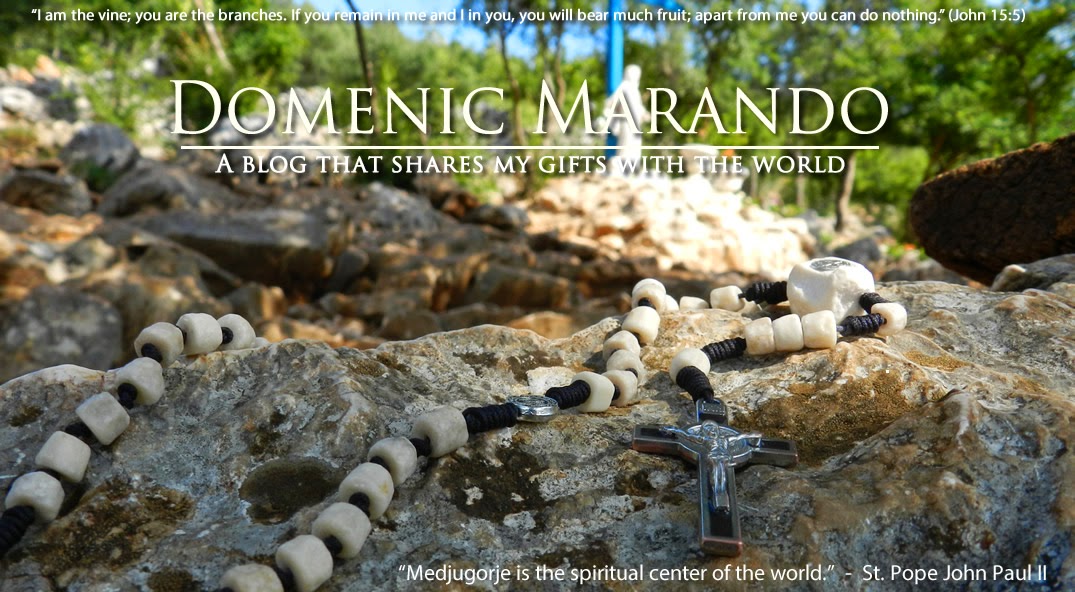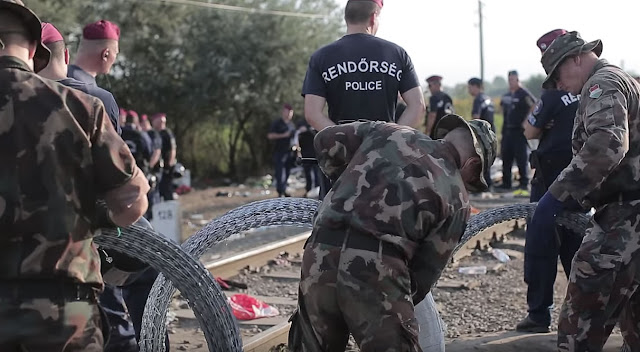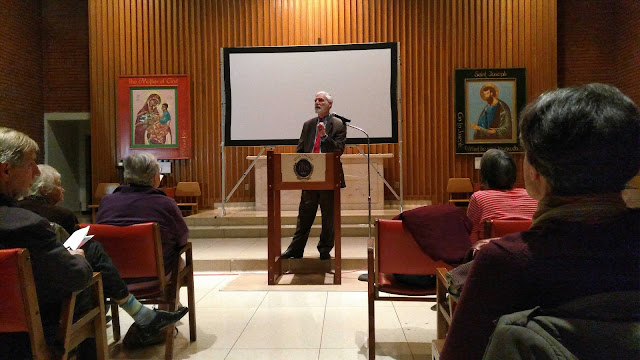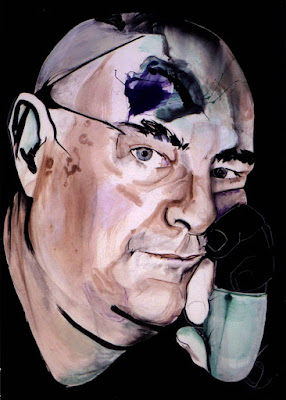 |
| The hordes of migrants pouring into Europe. Photo: The Geller Report/Germany has 7,000 JIHAD TERROR SUSPECTS who are ‘almost IMPOSSIBLE’ to track |
Recently I read a blog post from the Hungarian government website, No, the Hungarian refugees of 1956 are not the same as today's migrants. When I had first seen it, the title immediately caught my attention and reading it proved to be time well spent. The author, Zoltán Kovács, put the current European migrant crisis into perspective by referring to the Hungarian experience, debunking in the process the false parallel drawn by some that the two groups are the same.
I thought it fitting to write about Kovács's blog post seeing how it closely connects with my previous post, Viktor Orbán: A True Leader of and for the People of Hungary and Hungary's Constitution The Fundamental Law of Hungary. Hungary, under the leadership of Prime Minister Viktor Orbán, has emerged as one of the leading countries fighting against illegal immigration, and the European Union's imposition of its "mandatory quota system."
Anyone who is somewhat well read on the history of Hungary will recognize the truth asserted in the title of Kovács's blog post. It is a truth that Kovács elaborated on with four main points, preceded by a brief description of the circumstances of the 1956 Revolution, that led to two-hundred thousand Hungarians leaving their homeland.
What Kovács has effectively done is deflect the criticism that Hungary's Prime Minister Viktor Orbán—whose most noteworthy speech of March 15, 2016 captured the nationalistic sentiments of the Hungarian people—has received regarding Hungary's immigration policy and the closure of its southern border with Serbia.
The departure of 200,000 Hungarian refugees in 1956
Kovác's blog post begins with a brief history of the event that led to two-hundred thousand Hungarians fleeing from Hungary. It all began on October 23, 1956, when Hungarian university students demonstrated against the Communist Hungarian government—asserting the right to be independent from all foreign powers and that Hungarians should enjoy the rights of free people in a democratic system—and provoked a violent response.
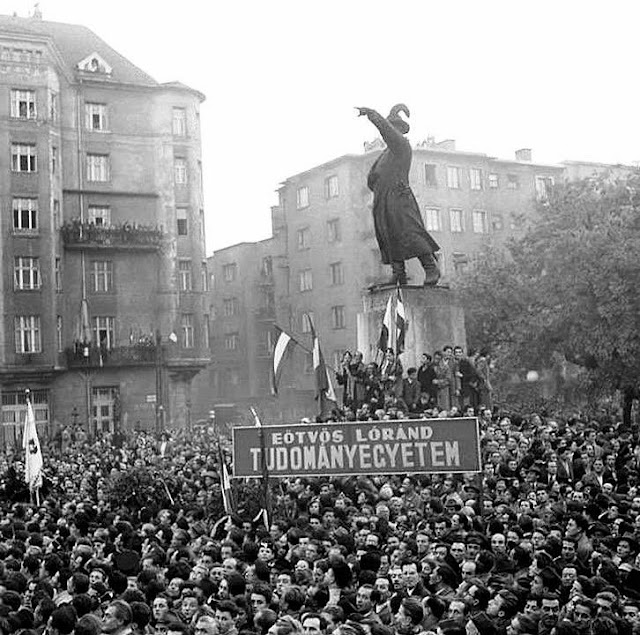 |
| Eötvös Loránd University, Józef Bem monument in Budapest on October 23, 1956, where students began to demonstrate against the Communist government. Photo: Bojár Sándor |
That day the students were joined by others and as the numbers grew, the demonstration had encompassed much of Budapest. By nightfall, the State Security Police, fired and killed several demonstrators outside the state radio building.
This demonstration ushered in the Hungarian Revolution of 1956. Many believed it would bring freedom to Hungary, only to be met by the sad reality of the Soviet Union's response—that effectively crushed the revolution—which took many from a feeling of euphoria to despair. The result was that people once again began to live in fear, unable to speak and live freely.
The Soviet Union sent Red Army enforcements into Hungary, adding to those already there, bringing the total force to seventeen divisions. The attack against the people began on November 4, and with the overwhelming force of Soviet tanks, artillery, and air strikes, the revolution was crushed.
The violence and repression became too much for many, resulting in the departure of two-hundred thousand Hungarians from their homeland, most of whom arrived in Austria. It was the largest wave of refugees in Europe's post-World War II history and inflicted a terrible loss on Hungary.
The false parallels between the 1956 Hungarian refugees and the migrant crisis that escalated in 2015
Kovács went on to deflect any parallels between the Hungarian refugees of 1956 and today's Middle Eastern "refugees."
He argues that the real purpose why some consider both groups the "same," and have tried to draw a parallel between the two, is to criticize Prime Minister Viktor Orbán and the Hungarian government for the building of fencing on its borders—securing Hungary from massive waves of so-called Middle Eastern "refugees" in the process—and Hungary's policy to limit immigration. Kovács sums up their criticism, "In short, they say, when Hungarians fleeing the Soviet crack down were welcomed with open arms in 1956, how can Hungary be so cold in its response to today’s migrants?" Kovács responded to this with the following:
It’s a seductive argument; afterall, people love a neat parallel. And any reasonable person can see similarities. Millions of Syrians have fled a civil war of unspeakable brutality and some of them are among the migrants attempting to come to Europe. But all things considered, this argument doesn’t hold up. The two are simply not the same.Kovács expanded upon why that argument "doesn't hold up," with four compelling points: first, they are two very different groups connected by very different events; second, there is the question of security and the connection between migration and terrorism; third, the concern for basic law and order when crossing the border into a host country; and fourth, that the subject of borders is also a matter of cultural frontiers.
 |
| Hungarian refugees in 1956 boarding a train for Austria. Photo: Website of the Hungarian Government/About Hungary Blog |
They are two very different groups connected by very different events
In 1956, those fleeing Hungary did so as a result of one major event, the brutal crackdown by the Soviet Union. The Hungarians fleeing the country were people who were trying to escape the violence and in many cases the threat of reprisals. To put a fine point on it Kovács stated, "There was no question about their nationality and the reason for their crossing the border. It was a homogenous group of people with a clear story."
This has not been the case with Europe's current migrant crisis. In early 2015, those attempting to cross the European Union's Schengen border into southern Hungary, were illegals from Kosovo. Add to this the more recent flow of "refugees" from Afghanistan, Iraq, Pakistan, northern Africa and Syria.
Many do not have the proper documentation! Others claim to be Syrian migrants, lying in the process, and do so because it is perceived to be more advantageous; that is, a Syrian national has a better chance at receiving asylum. Some are fleeing war, but there are those who are simply "economic migrants," taking advantage of the current crisis. Together they all comprise a heterogenous group that are very difficult to document.
The question of security and the connection between migration and terrorism
The Islamic State has boasted about exploiting the migrant crisis and weak border controls to move operatives in and out of Europe. Kovács cites a few examples.
 |
| Immigrants are escorted by German police to a registration centre, after crossing the Austrian-German border in Wegscheid near Passau, Germany, October 20, 2015. Photo: REUTERS/Michael Dalder |
The first was the Paris attacks on November 13, 2015. A report from the Washington Post, Tracing the path of four terrorists sent to Europe by the Islamic State, details how two of the four terrorists, successfully infiltrated into Europe and set off their suicide vests outside the Stade de France.
In November'2015, Hungarian law enforcement apprehended two British nationals, who were banned from traveling abroad for their financial terrorism, suspected to be on their way to Syria.
Then there is the disturbing report in Germany in which it was determined that migrants committed or tried to commit sixty-nine thousand crimes in the first quarter of 2016. The report stated, "There was a record influx of more than a million migrants into Germany last year and concerns are now widespread about how Europe's largest economy will manage to integrate them and ensure security."
The concern for basic law and order when crossing the border into a host country
The Hungarian refugees of 1956 requested protection first in Austria, the first safe country in which they arrived. The process of entry into Austrian society required going to temporary lodging or camps, sometimes waiting for months until each individual case could be decided.
This is stark contrast to the migrants coming into Europe today, many of whom come from and are funnelled through Syria. Many of the migrants flaunt the rules of migration from country to country, until they reach their final destination.
 |
| Razor sharp fencing that Hungary typically uses at its borders, like at the Border Crossing Station at Roszke and Horgosz, near the southern border with Serbia, to stave off the hordes of Middle Eastern migrants trying to cross into Hungary. Photo: RafaVideoart/Hungarian army stopped Refugees in Roszke and Horgosz Hungary |
The migration route that migrants have to follow to get to Hungary passes through several safe and stable countries, but they do not seek protection in those safe countries as the international treaties require. Instead, many continue on their migration, crossing into other countries along the way, such as was the case in Hungary in 2015. Here is how Kovács spotlighted this reality, "Many of those that crossed illegally into Hungary in 2015, simply refused to cooperate with the asylum procedure and instead demanded to be taken to Germany or another European host country as if it were their right."
The subject of borders is also a matter of cultural frontiers
Kovács noted that the " '56ers" crossed a political demarcation between two states, who for centuries had a close relationship, under the Habsburg Monarchy, and later the dual monarchy of Austria-Hungary that lasted until World War I. Austrians and Hungarians courageously fought against a common enemy, the Ottoman Empire, that tried to aggressively expand into Europe. Austria and Hungary also share a common Judeo-Christian heritage. Kovács noted, "When Austrians received the ‘56ers, it was like they were taking in their cousins."
This is not the case with the current group! As Kovács stated, "The culture of these migrants most definitely does not have that relationship with our Judeo-Christian culture." This is a reality that can not be ignored, to which Kovács added a touch of sarcasm, "We can ignore the elephant in the room and pretend that their assimilation in Europe is not an issue."
To further spotlight the importance of the cultural frontiers, Kovács quoted German Chancellor Angela Merkel, from a speech in 2010:
[T]he beginning of the 60s our country called the foreign workers to come to Germany and now they live in our country…We kidded ourselves a while, we said: 'They won't stay, sometime they will be gone', but this isn't reality.
And of course, the approach [to build] a multicultural [society] and to live side-by-side and to enjoy each other... has failed, utterly failed.Kovács pointed out that Hungary has not denied the humanitarian dimension of the current migrant crisis. This has been demonstrated with the humanitarian aid Hungary has provided and the proposals it has put forth to provide aid to the "first safe countries" on the front lines, such as Turkey and Jordan, in an effort to help them better manage the influx of so many people.
In conclusion Kovács stated, "But anyone who compares this to the 200 thousand Hungarian refugees of 1956 ignores more than a few essential differences."
